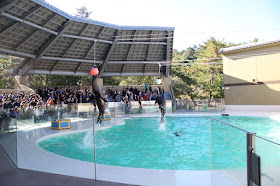Miyajima
Public Aquarium is a small facility located on popular tourist destination Miyajima Island
in Hiroshima Prefecture
Local Environs
The entrance area is decorated
with a recreation of the orange architecture of the Itsukushima Shrine.After entering, visitors first encounter an exhibit of the mudflats found near Itsukushima Shrine.
Blessings of the Sea
After the mudflats, visitors
ascend to the second floor where they will see the “Blessings of the Sea” area
which focuses on explaining oyster aquaculture in the Seto Inland Sea.Visitors can peer straight down into the oyster tank which, consistent with oyster aquaculture, features oysters attached to hanging ropes.
This tank occupies two floors. The below photo shows the part of the oyster tank which is visible on the second floor.
Later, when visitors descend to the first floor, they will encounter the bottom part of the oyster tank.
From Mountains to the
Sea
This area is said to recreate
the landscape from the upper river basin down to where the river flows into
the sea.Barbel eels (Plototus lineatus)
There was a display of Japanese horseshoe crabs (Tachypleus tridentatus) .
The following exhibits show recreations of the upper river environment.
Sea of Healing
This was the largest
fish-inhabited tank in the aquarium.
Like the oyster tank, it occupied two floors. The photo below shows the part of the tank
visible from the second floor.This tank included a pair of Blacktip reef sharks (Carcharhinus melanopterus) that were about 1.5 meters in length.
The below photo shows the part of the large tank visible from the first floor.
Whales of the Seto
Inland Sea
There was a large tank housing
two Sunameri (Finless Porpoises). These
animals live in the Seto Inland Sea. The
Sunameri tank was about 12 to 14 meters long, about 7 to 9 meters wide, and about
4 to 5 meters deep. The tank was plain
and unadorned and looked like the inside of a swimming pool.
Various Small Exhibits
The aquarium featured many small
tanks housing ocean creatures.
Penguins and Sea lions
As mentioned earlier, the
aquarium’s collection also included some animals not native to the Hiroshima
area. These cute and charismatic
creatures are likely included to help attract increased numbers of visitors. The first of these creatures that I
encountered were the penguins. Like the “Sea
of Healing”, this exhibit could also be viewed from both the first and second
floors. The part of the exhibit visible
on the second floor featured a recreated rock cliff.There was also a part of the exhibit where visitors could walk above the swimming penguins.
The penguins that were viewed from above could also be viewed from below.
They can also be viewed from the side.
This is what the penguin exhibit looks like from the first floor.
Directly across from the penguins were the sea lions.
Asian small clawed
otters
Another pair of cute
charismatic animals was the Asian small clawed otters. Their tank was about 3
or 4 meters long and only about 2 meters wide.
Live Show Pool
Outside, there was a pool
where sea lions did live performances.
Food and Souvenirs
The Miyajimarine Kitchen was
found on the second floor. This
restaurant used the ticket vending machine system. Customers buy tickets for what they want to
eat and place their orders by handing the ticket to the employee manning the
counter. This system is often confusing for first-time visitors to Japan. Fortunately, this restaurant posted an illustrated explanation.
The restaurant also had a list of food ingredients for customers with allergies.
The restaurant had 52 seats.
I ate a curry rice and coke set that cost 800 yen.
The aquarium also had a very well-stocked souvenir shop with lots of cute original characters.
Rocky Shore of
Friendship
There
was a touch pool which featured small crustaceans and invertebrates which visitors
well allowed to handle. Visitors were
also allowed to put their feet into the shallow pool.
This sunameri-costumed staff member was stationed near the boat landing to help attract visitors to the aquarium.
Getting There
Visitors
can travel from Hiroshima Station by the JR train line (about 25 minutes) and
get off at the Miyajimaguchi station.
From the station, it is about a 5-minute walk to the Miyajima pier where
you can catch the ferry to Miyajima Island.
A ticket for the ferry was 180 yen. After landing on Miyajima Island, it
is about a 25-minute walk from the pier to the aquarium. Along the way,
visitors walk past the World Heritage Itsukushima Shrine and many small
shops. Admission to the aquarium for
adults was 1400 yen. Junior high school
and elementary school students were 700 yen.
Young children aged 4 and above, but not yet in school, were 400
yen. Children younger than 4 years old
were allowed in free.
(Note:
All photos in this post were taken during a visit made on November 24, 2018. The comments in this post are based on
observations made at that time.
Conditions may have since changed.
Please check it out for yourself!)





























































